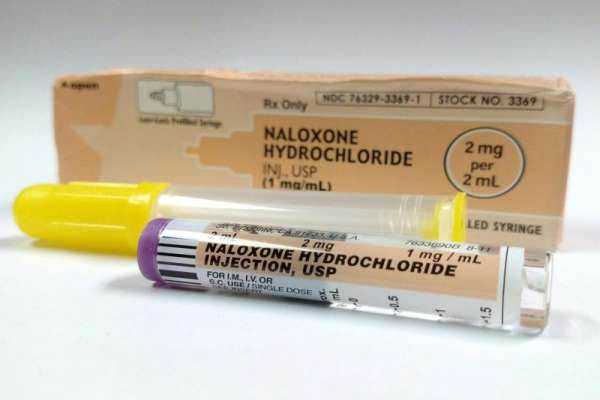
U.S. researchers said Wednesday that they had identified a new drug that could supercharge the most common overdose medication, naloxone. Photo by Mark Oniffrey/Wikimedia Commons
U.S. researchers said Wednesday that they have identified a new drug that could make inroads on the devastation caused by opioids — by supercharging naloxone, branded as Narcan, the standard overdose antidote.
The team from Washington University School of Medicine in St. Louis, Stanford University and the University of Florida found a method of making naloxone stronger and longer lasting that was capable of reversing the effects of opioids in mice at low doses without worsening withdrawal symptoms, Washington University said in a news release.
The results, set out in a proof of concept study published Wednesday in the science journal Nature, show combining naloxone with a molecule that modifies the response of opioid receptors on neurons in the brain boosts naloxone’s overdose-reversing ability to deactivate the receptors, and for significantly longer.
“Naloxone is a lifesaver, but it’s not a miracle drug; it has limitations,” said co-senior author Susruta Majumdar, a professor of anesthesiology at Washington University.
“Many people who overdose on opioids need more than one dose of naloxone before they are out of danger. This study is a proof of concept that we can make naloxone work better — last longer and be more potent.”
Opioids, including fentanyl and oxycodone, work by slotting into a pocket on the opioid receptor, triggering a cascade of molecular events: reducing the perception of pain, inducing a sense of euphoria and slowing breathing.
The latter effect is what makes opioids so deadly, killing tens of thousands of Americans every year.
Naloxone is also an opioid and as counterintuitive as it seems to treat an overdose by giving more opioids naloxone, unlike most opioids does not activate the receptors, displaces harmful ones from the pocket on the receptor, deactivating it and thereby reversing the overdose.
However, the action of naloxone only lasts about 2 hours before it detaches from the receptor, allowing longer-lasting opioid molecules, such as fentanyl, which can remain in the bloodstream for 8 hours, to reattach and reactivate the receptor. That causes overdose symptoms to return.
The team discovered the compound described in their paper — dubbed 368 — from working through a library of 4.5 million molecules in the lab in search of those that bind to the opioid receptor with naloxone already tucked into the receptor pocket.
Tests found 368 made naloxone 7.6 times more effective at inhibiting the activation of the opioid receptor, in part due to naloxone remaining in the binding pocket at least 10 times as long as when it was given on its own.
“The compound itself doesn’t bind well without naloxone,” said lead author Evan O’Brien, a postdoctoral scholar in Kobilka’s lab at Stanford. “We think naloxone has to bind first, and then compound 368 is able to come in and cap it in place.”
Compound 368 also improved naloxone’s ability to counteract opioid overdoses in mice and enabled naloxone to reverse the effects of fentanyl and morphine at 1/10th the usual doses — without making their withdrawal symptoms worse.
Naloxone can trigger withdrawal symptoms in people such as pain, chills, vomiting and irritability as the medication effectively cancels out the drugs in their bodies.
“We have a long way to go, but these results are really exciting,” said Jay P. McLaughlin, a University of Florida professor of pharmacodynamics.
“Opioid withdrawal likely won’t kill you, but they’re so severe that users often resume taking opioids within a day or two to stop the symptoms. The idea that we can rescue patients from overdose with reduced withdrawal might just help a lot of people.”
The compound is one of several molecules that show promise as so-called negative allosteric modulators of the opioid receptor, part of a promising new research field looking at altering how the body responds to drugs by fine-tuning the activity of drug receptors rather than the drugs themselves.
The team has filed for a patent and is working on narrowing down and characterizing the most promising candidates, but Majumdar estimates that it will be 10 to 15 years before a naloxone-enhancing negative allosteric modulators of the opioid receptor comes to market.
“Developing a new drug is a very long process, and in the meantime new synthetic opioids are just going to keep on coming and getting more and more potent, which means more and more deadly,” Majumdar said.
“Our hope is that by developing a [negative allosteric modulator], we can preserve naloxone’s power to serve as an antidote, no matter what kind of opioids emerge in the future.”

